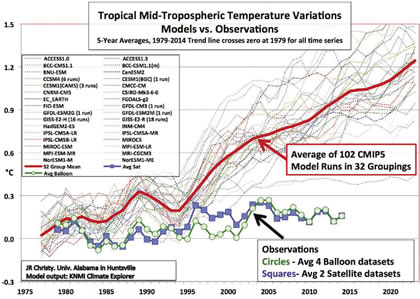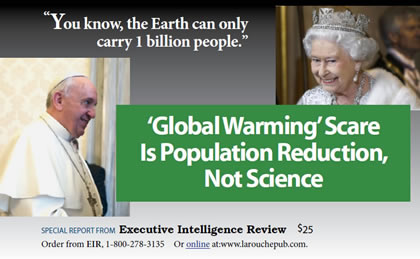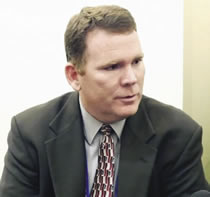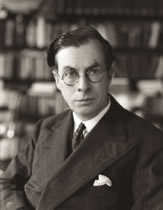EXCELLENT! NOW FUSION, NEW SILK ROAD
President Trump Dumps Paris Climate Accord
by Benjamin Deniston
June 2017
A PDF version of this article appears in the June 9, 2017 issue of Executive Intelligence Review and is re-published here with permission.

Benjamin Deniston |
June 3—The following is an edited transcript of a presentation by Benjamin Deniston, delivered on the June 2, 2017 LaRouche PAC Friday Webcast.
President Trump’s announcement that the United States is going to pull out of the Paris Climate Accord is a really big deal; this is excellent. To my knowledge, this is the first U.S. President who has actually kicked back against this whole climate change scare in a serious way. The Clinton Administration pushed it; despite the narrative of this being a Republican versus Democrat issue, the George W. Bush Administration went along with the broader program, as with the insane biofuels program, for example; and Obama pushed it big time. Now, we finally have a President who is actually kicking back against this.
This is very important. Trump deserves respect and support for fighting against this climate change scare, because this isn’t just some policy issue, this decision is confronting a coordinated global campaign run by the highest levels of the Anglo-Dutch oligarchy. Now we have the chance to end this Malthusian program and get back to growth and development, if President Trump can follow this up by joining the new global development paradigm being led by China’s New Silk Road development policy.
Economics
It was important that Trump highlighted the economic effects of CO2 reduction schemes during his announcement. Some try to limit the discussion to an academic debate, but there is the reality of the manner in which this is affecting the general population. What’s the effect on your citizens of going with these policies? They say CO2 is terrible, it’s a pollutant, and therefore, we must to go with all these wonderful, clean energy solutions. They paint this rosy picture about green energy, when in fact it has devastating effects on the real-life conditions of our population. This whole Green energy narrative is ridiculous.
If you want to talk about the reduction in CO2emissions and the Green energy programs, look at what Germany is facing in terms of their energy prices. This is an important case study in what happens when you massively subsidize wind and solar, while abandoning nuclear and reducing fossil fuels. In Germany, between 2004 and 2015, their energy prices went up 50%, from $0.23 cents a kilowatt-hour in U.S. values, to $0.35 cents a kilowatt-hour. They were already, in 2004, twice the rate we pay in the United States on average. But over that ten-year period—driven by CO2-reduction efforts, green energy, and then the nuclear exit—prices went up another 50%, to three times what Americans pay on average for energy. What does this mean for your economy? For your industry? For your poorer population? This has already been driving industries to leave Germany.
In 2013, just one subsidy in Germany—a major surcharge added to residential power bills to pay for wind and solar—was the equivalent of $0.07 per kilowatt-hour. That alone is 60% of what we pay on average in the United States. This is just for one subsidy, just for wind and solar.
View full size
John Christy, Professor of Atmospheric Science and State Climatologist at the National Space Science and Technology Center, University of Alabama, Huntsville, Alabama; presented at a May 13, 2015 House Committee on Natural Resources hearing. |
This surcharge is before the massive, extra expense of new transmission systems, battery banks, and related aspects of a so-called “smart grid” infrastructure system (needed to handle the irregular surges and collapses inherent in wind and solar) are added.
Most importantly, these cost values are shadows of a physical principle: LaRouche’s metric of energy flux-density. Human progress is characterized by increases in energy flux-density, associated with fuels with higher energy densities and new domains of physical chemistry.
The idea that we can transition to some wonderful world powered by wind and solar electricity is a farce; it’s a fraud. These power sources inherently have a lower energy density, necessitating a higher physical cost to society per unit of power supplied. We need to go in the other direction, and to the degree necessary, use oil, coal, and gas in the context of existing infrastructure systems, while rapidly developing the more advanced, higher forms of energy such as nuclear fission and fusion—that’s really the future. The future is increasing energy use per capita, increasing the use of higher qualities of energy per capita.
What Does CO2 Not Do?
Secondly, in the context of the freakout reaction to Trump’s exiting from the Paris Accord, it’s worth re-examining the issue of rising atmospheric CO2 levels. What does CO2 do? It’s now officially labeled a pollutant by the EPA, and the media bombards you with claims that it will cause disastrous, extreme weather, catastrophic climate change, flood our cities with sea-level rise, and create a mass extinction of species. All bunk.
A lot could be said, but let’s just highlight one study, comparing 32 different climate models’ predictions of the effects of CO2 increase, with the reality that’s happened just in the last couple of decades.
The many thin dotted lines [in the graph above] are what these computer models predict for temperature rise due to CO2 increases, and the thick red line is their average prediction (based on a run from 1979). But compare that to the actual observations indicated in the blue and green lines (the squares and the dots). You see that none of the computer models have been accurate in predicting what actually happened. Satellite measurements derived from two different assessments, as well as independent in situ measurements with balloon systems, have shown that the temperature over the past 15 years has been relatively flat with little or no increase—despite the largest increases in CO2 levels in recorded human history. None of the models predicted this global temperature flatline, they all predicted significant global temperature rise (as a response to the CO2 increase). So, have this in mind when you hear these scare stories about CO2 increase being some terrible thing. They’re basing it all on these models that have already been shown to be ridiculous.
What Does CO2 Actually Do?
Dr. Craig Idso, Carbon Dioxide SpecialistJune 3—Below are excerpts from a March 23, 2017 interview with Dr. Craig Idso, conducted at the Heartland Institute’s 12th International Conference on Climate Change (ICCC-12). Dr. Idso is the founder of the Center for the Study of Carbon Dioxide and Global Change. He is a member of the American Association for the Advancement of Science; of the American Geophysical Union; of the American Meteorological Society; and of the CO2 Coalition.
Dr. Craig Idso: There are three main benefits which result from increasing carbon dioxide concentrations in the atmosphere: The first is that it increases plant productivity for biomass of the plant. On average, what we see is that for a doubling of CO2, something that’s going to happen by the end of this century, most are herbaceous plants, non-woody plants like crops and things like that, will experience anywhere from a 25% to a 55% increase in biomass per yield. And that’s a phenomenal result and that’s something that’s going to happen just because we raise the CO2 concentration and nothing else. . . . Second is that higher CO2 concentrations help increase the plant’s water use efficiency. Again, a doubling of CO2 allows plants to use about half as much water as they need to produce the same amount of tissue, so that is another phenomenal benefit. And then the third benefit is that higher CO2 concentrations help to ameliorate environmental stresses. So if you have a stress from hot air temperature, maybe low light, low levels of soil fertility, those sorts of things, if you have higher CO2 concentrations, the higher levels tend to reduce or lessen that stress, if not completely ameliorate it under a doubling of CO2. You put all those three benefits together, and what you get is a tremendous benefit to the biosphere, to the growth. And we’re seeing that already: We see it in tree-ring cores, you can look at how their water use efficiency has improved over time, and we see anywhere from 35% to 40% increase already, as the CO2 concentration has increased by about 40%.... So the satellites have been up measuring reflectivity of vegetation, over the entire globe ever since about the early 1980s. And what they find consistently, whether they’re focusing on a particular region of the globe or the globe as a whole, you get anywhere from about 6% to 15% increase in biomass in that period of time.... The globe as a whole, or in total, is actually in a better off condition now than it was when those measurements began.... I did the first approximation to determine what is the net monetary benefit on crop production globally, in the past and then also projected into the future, and what I found was that over the 50-year period from 1961 to 2011, it amounts to about $3.2 trillion on the global economy, a phenomenal benefit. And then, projecting that forward in time, as the CO2 concentration is going to continue to rise, from about 2012 to 2050, we expect it to be about $10 trillion to the economy. And that’s just really scratching the surface, because you could look at studies—for example, I’ll take rice, where there’s a number of genotypes of rice, and scientists have looked at, for example—in one study I’m thinking of—they looked at 16 different genotypes of rice, and how those genotypes responded to a doubling of CO2, and they received values that ranged from about zero all the way to a whopping 265%. So, if governments and scientists focused on those specific genotypes that we received the greatest increase in biomass per unit of CO2 rise, and then grew them, we could have this phenomenal increase in agriculture and have no problem in feeding the planet in the future. |
But there’s another interesting aspect to the CO2 issue, which isn’t discussed at all. Apparently, it’s a secret for many of these fear-mongering climate change pundits, that CO2 is actually a critical part of the biosphere. People talk about being “pro-green”—CO2 is totally pro-green, it’s as green as you get!
A few weeks back I had the opportunity to interview a scientist who has reviewed and consolidated thousands of studies showing the positive effects of higher CO2 levels on plant life. Dr. Craig Idso is the Founder of the Center for the Study of Carbon Dioxide and Global Change, and a member of CO2 Coalition.
His work covers controlled experiments with greenhouses (studying different plant species at different CO2 levels), assessments of the implications of this for agriculture, and satellite measurements of regional and global biospheric activity.
The results of these studies are remarkable and speak for themselves. According to global satellite measurements, over the past 35 years the entire biosphere has seen a 6% to 15% increase in total plant biomass production. We’re not talking about a 10th of a percent or a half of a percent, but 6% to 15% for the entire globe; that’s huge.
Based on the controlled greenhouse studies, Dr. Idso has been able to determine that the rising CO2 levels in recent decades have increased agricultural crop yields by over $3 trillion—more food and more efficient agriculture production.
And another benefit—which is a big irony, in a certain sense—is the effects of higher CO2 levels on plant water use efficiency. You actually get a highly significant boost for certain plant species in their ability to produce more biomass with less water use. This has rather interesting implications for drier regions in particular, where water is the limiting factor in plant growth. And now, all of a sudden, with higher concentrations of plant food in the atmosphere, CO2, they can grow in regions they couldn’t grow in before; they can be healthier in regions they couldn’t be healthy in before. And you just take a look at places we’ve had water issues—like California—and we have our crazy governor in California, running around pretending he’s the world leader on CO2, when his state is actually benefiting from the fact there’s been higher CO2 levels in the context of the recent droughts. The ironies are just all over the place.
A Top-Down, Imperial Policy
You’ve really got to ask yourself, why are none of these basic scientific facts even being added into the discussion about effects of CO2 rise? All you hear are these flimsy scare stories, presented by the media as if they were scientific facts, but basic, unambiguous scientific data and studies demonstrating the positive effects of CO2 rise are completely left out of the discussion. People need to let that irony sink in.
Let’s talk about reality. For decades, Helga and Lyndon LaRouche have warned you, the whole global warming issue is not really about global warming. That’s just the latest scare story certain people have grabbed onto and pushed to bolster a Malthusian ideology (before global warming it was ozone holes, and overpopulation, and global cooling).
The Founding Fathers of the Environmentalist MovementPrince Philip
Sir Julian Huxley
Prince Bernhard
|
In 2015 Executive Intelligence Review released an updated report exposing the forces pushing this climate change scare, “Global Warming Scare Is Population Reduction, Not Science,” which details the origins, not just of the climate-change scare, but more broadly, of this whole environmentalist movement, demonstrating that it comes from an oligarchical, Malthusian ideology. Look at the climate issue in that context.
Just look at the founders of the modern environmentalist movement, the people who created the entire structure that pushed this whole environmentalist movement globally. Just highlight the top figures: Sir Julian Huxley, a lifelong proponent of eugenics, who was head of the British Eugenics Society. After World War II, after Hitler’s horrific war crimes and crimes against humanity were exposed, along with their connection to eugenics, Huxley still promoted eugenics in his position in the UN, as the head of UNESCO at the time. Prince Philip, whenever he gets the chance, talks about how terrible population growth is, and the fact that population growth is the number one problem on the planet. He has said that if he could be reincarnated, he’d like to come back as a deadly virus to reduce world population. That’s his view, that’s his belief-system. Prince Bernhard of the Netherlands was actually a Nazi, and then worked for Nazi intelligence (and there are credible accusations that he helped Nazi war criminals escape after World War II).
These people came together and started the environmentalist movement in the immediate post-World War II period, and in the ’50s and ’60s it started to take off. This is the ideology behind this. It’s not about the debates you see on the media, about this claim or that claim on supposed science of CO2. If you really want to understand the issue, it’s this oligarchical, Malthusian ideology that’s been campaigning for generations against economic development, against population growth, against the development of so-called Third World nations. These are people who have said we cannot allow the world to rise to the living standards of America and the West. Think of Obama traveling to Africa, telling students in Africa, if you all had air conditioning and cars the planet would boil over, so that’s not an option for you.
Dump the Past, Get into the Future
And that’s the issue. Despite what many may believe, the Paris Climate Accord is an expression of the old Malthusian, geopolitical paradigm—it’s the past—and what we’re seeing emerging with everything around China’s New Silk Road/Belt and Road Initiative (and its recent breakthrough leadership forum) is the future. So Trump’s dumping of this climate change issue is completely coherent with the fight to get the United States to break from this old geopolitical, zero-sum game, Malthusian paradigm, and get into building the future again.
Energy is certainly critical. Mr. LaRouche has defined the next steps: Concentrate on fusion and on nuclear fission as needed for the time being. The key is not only utilizing existing infrastructure for energy sources such as coal and natural gas, but developing the future energy sources that are going to do much more than allow moderate growth in energy use. What kind of energy production will enable nations around the world to come up to the same per capita energy use that we have in the United States now? What will support even higher levels, including in the United States? How can we dramatically increase the total energy-flux density of the entire global economy? That’s the future. The entire history of the development of mankind has always been intimately connected with, and tied to these kinds of increases in energy-flux density. That’s got to be the next step in development.
With China’s Belt and Road Initiative, the world is moving in that direction, and if the U.S.A. joins that process, we can secure this shift—this can’t be stressed enough. We are on the verge of a global, historical paradigm shift, this provides the perspective of the end of a geopolitical system. We have to get Americans to understand the depth of this ongoing revolution, and the importance of the United States jumping on board with this, immediately. If you now get the United States on board with Russia and China, and the nations allied with them, that’s it. We can have the future, we can create the future we want with that alliance.
|
Click here for more information and to purchase  |



 Sir Julian Huxley
Sir Julian Huxley Prince Bernhard
Prince Bernhard